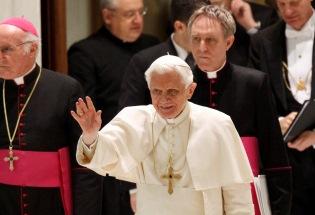<p><br>
<strong>Vatican Correspondent</strong></p>
<figure id="attachment_16895" aria-describedby="caption-attachment-16895" style="width: 315px" class="wp-caption alignright"><a class="highslide" onclick="return vz.expand(this)" href="https://cms.laprensa.org/sites/default/files/2012/03/pope-benedict-audi… loading="lazy" class="size-full wp-image-16895" title="POPE-AUDIENCE" src="https://cms.laprensa.org/sites/default/files/2012/03/pope-benedict-audi…; alt="" width="315" height="215" srcset="https://cms.laprensa.org/sites/default/files/2012/03/pope-benedict-audi… 315w, https://cms.laprensa.org/sites/default/files/2012/03/pope-benedict-audi… 300w" sizes="(max-width: 315px) 100vw, 315px"></a><figcaption id="caption-attachment-16895" class="wp-caption-text">Pope Benedict XVI greets an audience, in December. Photo by Paul Haring</figcaption></figure>
<p>Now that the Pope is in Guanajuato, Mexico, there’s one question that’s being raised over and over again…..Will his visit help stop the violence? Short term, the answer might be yes, but while that might be good enough for a few days, Mexican people are looking for a long term solution. Few expect the situation to change overnight, but people are definitely hoping the visit will trigger an eventual change.</p>
<p>“We’re hoping that the message of the Holy Father is one that resonates on a spiritual level,” says Mexico’s Ambassador before the Holy See, Hector Federico Ling Altamirano.”I think that among those criminals that have chosen to go down that path, there are also Catholics who respect the Pope.”</p>
<p>Reports show that since 2006, roughly 50,000 people have died in Mexico’s drug war. The violence has gotten world wide attention as thousands have reluctantly fled their native country in exchange for security and peace of mind.<br>
“Yes, the Pope’s trip comes at a time when insecurity is a major problem for both Mexico and Latin America,” says Fr. Jorge Osio López, a Mexican priest who studies at Mexico’s Pontifical College in Rome. “People are expecting a message that will inspire.”</p>
<p>A lot is riding on this visit. If it doesn’t help cease the violence, some are hoping it will at least lift people’s spirits.</p>
<p>In fact, faced with this social crisis, president Felipe Calderon visited Rome last year with a direct invitation. On May 1, 2011, Calderon attended John Paul’s Beatification ceremony at the Vatican. There, before television cameras, the president formally greeted Benedict XVI, just as other world leaders did. But this diplomatic visit had a slightly different twist…Calderon made it a point to publicly invite the Pope to Mexico. “We need you more than ever,” said the president, as TV cameras recorded. He then paused and added “We are suffering.”</p>
<p>Seven months later, on December 12th, a loud cheer rang out in St. Peter’s Basilica, when Benedict XVI announced he would visit Mexico and Cuba from March 23rd-29th. It’s a move that’s somewhat unknown for both the Vatican and Mexico, especially since it’s Benedict XVI’s first visit to these two countries. John Paul II, was widely welcomed in Mexico by millions of people during his five papal visits. But this time around it’s another Pope visiting another Mexico.</p>
<p>“Yes, it easy to see that Benedict XVI isn’t as charismatic as John Paul II was,” says Alfonso Giordano, Director of the European Center for International Affairs. “He is a professor, a theologian. He has a very strong message, but he doesn’t always know how to get it across.”</p>
<p>Aside from the rise in violence, much has changed since John Paul last visited Mexico. When it comes to religion, the country is actively going through changes. According to the Vatican, Mexico’s population is roughly 90 percent Catholic. Statistics vary though. The Pew Research Center states the country is roughly 85 percent Catholic. Either way, worldwide, after Brazil, Mexico is the second country with the most Catholics. But while number of baptized Catholics hold steady, actually practicing the religion is often seen as something separate.</p>
<p>According to experts this decrease in religious practice, is linked to immigration.</p>
<p>“It’s something that can’t be ignored,” says Giordano. “It’s a recent phenomenon. Millions of Mexicans have gone to the U.S looking for work. But when they leave their country, they also leave their religious practice behind. They get accustomed to the life in the U.S, which revolves heavily around work. The family dynamic and even the religious dynamic begins to change. It’s something that’s seen in the immigrants who decide to go back to live in Mexico.”</p>
<p>Even though one could argue that the country is still traditionally and culturally Catholic, there has been a notable shift in Mexico’s southeast region, where Mexicans are becoming Protestants and Evangelicals. But there is still one uniting force: Our Lady of Guadalupe, known as the ‘Queen of Mexico.’</p>
<p>“People who are Methodist, Evangelical and of other religions, when they hear someone talk about Our Lady of Guadalupe, they say, ‘OK, don’t go there,’” says Ling Altamirano. “You can fight all you want with the Catholic Church, but don’t touch Our Lady of Guadalupe.”</p>
<p>Perhaps it was no mistake then, that Benedict XVI decided to announce his visit precisely on December 12th, the day of Our Lady of Guadalupe. Among Mexican’s there’s a popular saying that reads “Mexico may be 85 percent Catholic, but it’s 100 percent ‘Guadalupano,’” meaning devotees of Our Lady.</p>
<p>In a way, the apostolic visit will be a give and take; for the Vatican, it’s a way to boost Catholicism in Latin America. For Mexicans, it’s a chance to pause for a moment……and hope for peace.</p>
Image
Image

Category